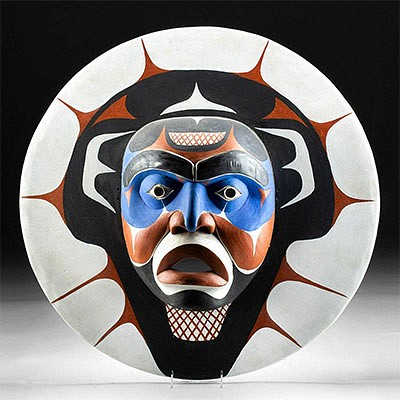19th C. Tahitian Cotton Chasuble (for Catholic Priest)
Lot 111a
About Seller
Artemis Fine Arts
686 S Taylor Ave, Ste 106
Louisville, CO 80027
United States
Selling antiquities, ancient and ethnographic art online since 1993, Artemis Gallery specializes in Classical Antiquities (Egyptian, Greek, Roman, Near Eastern), Asian, Pre-Columbian, African / Tribal / Oceanographic art. Our extensive inventory includes pottery, stone, metal, wood, glass and textil...Read more
Estimate:
$2,400 - $3,600
Absentee vs Live bid
Two ways to bid:
- Leave a max absentee bid and the platform will bid on your behalf up to your maximum bid during the live auction.
- Bid live during the auction and your bids will be submitted real-time to the auctioneer.
Bid Increments
| Price | Bid Increment |
|---|---|
| $0 | $25 |
| $300 | $50 |
| $1,000 | $100 |
| $2,000 | $250 |
| $5,000 | $500 |
| $10,000 | $1,000 |
| $20,000 | $2,500 |
| $50,000 | $5,000 |
| $100,000 | $10,000 |
| $200,000 | $20,000 |
About Auction
By Artemis Fine Arts
Mar 18, 2021
Set Reminder
2021-03-18 10:00:00
2021-03-18 10:00:00
America/New_York
Bidsquare
Bidsquare : Pre-Columbian | Tribal | Oceanic
https://www.bidsquare.com/auctions/artemis-gallery/pre-columbian-tribal-oceanic-6520
Featuring Pre-Columbian, Native American, African / Tribal, Oceanic, much more. All items have been legally acquired and are legal to sell. Convenient in-house shipping. Artemis Fine Arts info@artemisgallery.com
Featuring Pre-Columbian, Native American, African / Tribal, Oceanic, much more. All items have been legally acquired and are legal to sell. Convenient in-house shipping. Artemis Fine Arts info@artemisgallery.com
- Lot Description
Polynesia, Tahiti, ca. 19th century CE. A colorful cotton chasuble, creamy white with large cotton patches of brilliant purple and red that resemble flying birds and butterflies. Bright orange ribbons form vertical borders around the central motif. The chasuble features a collared opening for the neck and ample openings to fall over the arms. The wide "bell-shape" of the vestment suggests that the priest who wore it was a traditionalist whose personal style harkened back to the medieval church - an important enough ideological position in the late 19th and early 20th century that the Church issued rulings on the shape of chasubles! The white, red, and purple all have symbolic meaning - white representing the resurrection of the dead, red the blood of the saints who died for their faith, and purple penance. Purple is also associated with Lent and Advent and this chasuble may have been made to be worn during these important times. Size: 56.5" W x 60" H (143.5 cm x 152.4 cm)
This would have belonged to a missionary, probably French, or possibly a native convert; France sent a mission to Tahiti in 1837 as part of a broader agenda of Catholicizing Polynesia.
Provenance: private Hawaii, USA collection; ex Tad Dale collection, Santa Fe, New Mexico, USA, 1960 to 2000
All items legal to buy/sell under U.S. Statute covering cultural patrimony Code 2600, CHAPTER 14, and are guaranteed to be as described or your money back.
A Certificate of Authenticity will accompany all winning bids.
We ship worldwide and handle all shipping in-house for your convenience.
#154551Light staining on surface and slight discoloration to fabric, especially the whiter areas, but overall in very nice condition.Condition
- Shipping Info
-
All shipping is handled in-house for your convenience. Your invoice from Artemis Gallery will include shipping calculation instructions. If in doubt, please inquire BEFORE bidding for estimated shipping costs for individual items.
-
- Buyer's Premium



 EUR
EUR CAD
CAD AUD
AUD GBP
GBP MXN
MXN HKD
HKD CNY
CNY MYR
MYR SEK
SEK SGD
SGD CHF
CHF THB
THB














